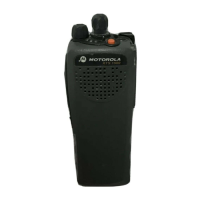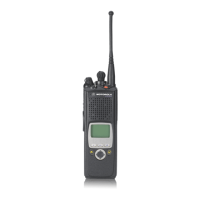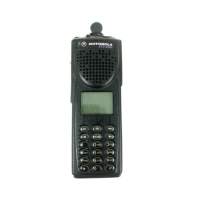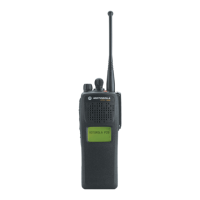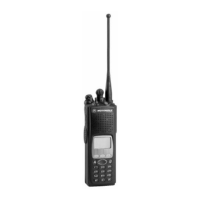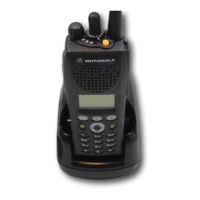Do you have a question about the Motorola XTS2500 and is the answer not in the manual?
Instructions for powering the radio on and off using the control knob.
Steps to select a radio zone and then a specific channel within that zone.
Guide to listening for transmissions and using the PTT button to speak.
Procedures for sending emergency alarms and calls.
FCC compliance statement for the radio, including Class B digital device classification.
Guidance on reading safety booklets and occupational use requirements for FCC RF exposure.
Legal notices regarding manual usage, copyrights, and disclaimers.
Explains warning, caution, and note notations for clarity.
Labeled diagram illustrating the physical components of the XTS 2500 Model I radio.
Detailed list of the radio's physical components and their corresponding page references.
Overview of customizable features and their programming page references.
Explains LED signals and various audible alert tones for radio status.
Further details on alert tones, including long, low-pitched, and short, medium-pitched tones.
Additional alert tones described, such as volume set, emergency exit, and low battery.
Instructions for turning the radio on and off using the volume control knob.
Guide to selecting radio zones and specific channels.
How to listen to transmissions and use the PTT button to transmit.
Procedure to adjust volume using the preprogrammed volume set button.
How to use the monitor button to check channel activity and adjust volume.
Instructions for listening for activity and setting continuous monitor operation.
Instructions for safely charging and handling the radio's battery.
Step-by-step guide for connecting and disconnecting the battery from the radio.
Steps for attaching and removing the radio's antenna.
Guide on how to attach and detach the belt clip to the radio's battery.
Instructions for removing and attaching the universal connector cover.
Details on attaching and removing the RSM adapter for accessories.
Features for selecting transmit power and managing squelch settings.
Managing transmission limits to prevent continuous transmission.
Introduction to emergency signaling capabilities like alarms and calls.
Steps to send a data transmission to identify an emergency.
Procedures for sending silent alarms and initiating emergency voice calls.
Overview of monitoring traffic on multiple channels by scanning.
How to start/stop scanning and temporarily remove unwanted channels.
How to change a channel's priority temporarily during scanning.
Steps to answer incoming landline phone calls on the radio.
Procedure for receiving and responding to one-to-one private calls.
How to respond to a call alert page, which functions like a pager.
Explanation of bypassing repeaters for direct communication or using repeaters for extended range.
Explains failsoft operation and out-of-range conditions.
Features for locking onto a specific site or manually changing sites.
Guidelines for cleaning the radio's external surfaces and handling precautions.
Information on maintenance agreements, service locations, and extended coverage plans.
Information on battery life, charging, and temperature considerations.
Guidance on choosing antennas based on frequency compatibility and color codes.
Lists compatible antennas and batteries for the radio.
Various carrying accessories and approved charging units.
Surveillance accessories, earpieces, and integrated microphone/receivers.
Various headset types and radio interface modules for audio accessories.
Steps for transmitting a distress call on VHF Channel 16.
Details on non-commercial channels and FCC frequency compliance rules.
Table of VHF marine channels with transmit and receive frequencies.
Definitions of terms from ACK to Conventional.
Definitions of terms from Digital Private Line to NiMH.
Definitions of terms from Non-tactical/Revert to Repeater.
Definitions of terms from Squelch to Zone.
Details of warranty coverage and for how long it is valid.
General warranty terms, state law rights, and how to obtain service.
List of conditions and damages not covered by the warranty.
Instructions for powering the radio on and off using the control knob.
Steps to select a radio zone and then a specific channel within that zone.
Guide to listening for transmissions and using the PTT button to speak.
Procedures for sending emergency alarms and calls.
FCC compliance statement for the radio, including Class B digital device classification.
Guidance on reading safety booklets and occupational use requirements for FCC RF exposure.
Legal notices regarding manual usage, copyrights, and disclaimers.
Explains warning, caution, and note notations for clarity.
Labeled diagram illustrating the physical components of the XTS 2500 Model I radio.
Detailed list of the radio's physical components and their corresponding page references.
Overview of customizable features and their programming page references.
Explains LED signals and various audible alert tones for radio status.
Further details on alert tones, including long, low-pitched, and short, medium-pitched tones.
Additional alert tones described, such as volume set, emergency exit, and low battery.
Instructions for turning the radio on and off using the volume control knob.
Guide to selecting radio zones and specific channels.
How to listen to transmissions and use the PTT button to transmit.
Procedure to adjust volume using the preprogrammed volume set button.
How to use the monitor button to check channel activity and adjust volume.
Instructions for listening for activity and setting continuous monitor operation.
Instructions for safely charging and handling the radio's battery.
Step-by-step guide for connecting and disconnecting the battery from the radio.
Steps for attaching and removing the radio's antenna.
Guide on how to attach and detach the belt clip to the radio's battery.
Instructions for removing and attaching the universal connector cover.
Details on attaching and removing the RSM adapter for accessories.
Features for selecting transmit power and managing squelch settings.
Managing transmission limits to prevent continuous transmission.
Introduction to emergency signaling capabilities like alarms and calls.
Steps to send a data transmission to identify an emergency.
Procedures for sending silent alarms and initiating emergency voice calls.
Overview of monitoring traffic on multiple channels by scanning.
How to start/stop scanning and temporarily remove unwanted channels.
How to change a channel's priority temporarily during scanning.
Steps to answer incoming landline phone calls on the radio.
Procedure for receiving and responding to one-to-one private calls.
How to respond to a call alert page, which functions like a pager.
Explanation of bypassing repeaters for direct communication or using repeaters for extended range.
Explains failsoft operation and out-of-range conditions.
Features for locking onto a specific site or manually changing sites.
Guidelines for cleaning the radio's external surfaces and handling precautions.
Information on maintenance agreements, service locations, and extended coverage plans.
Information on battery life, charging, and temperature considerations.
Guidance on choosing antennas based on frequency compatibility and color codes.
Lists compatible antennas and batteries for the radio.
Various carrying accessories and approved charging units.
Surveillance accessories, earpieces, and integrated microphone/receivers.
Various headset types and radio interface modules for audio accessories.
Steps for transmitting a distress call on VHF Channel 16.
Details on non-commercial channels and FCC frequency compliance rules.
Table of VHF marine channels with transmit and receive frequencies.
Definitions of terms from ACK to Conventional.
Definitions of terms from Digital Private Line to NiMH.
Definitions of terms from Non-tactical/Revert to Repeater.
Definitions of terms from Squelch to Zone.
Details of warranty coverage and for how long it is valid.
General warranty terms, state law rights, and how to obtain service.
List of conditions and damages not covered by the warranty.
| IP Rating | IP54 |
|---|---|
| GPS | Optional |
| Bluetooth | No |
| Frequency Range | 136-174 MHz, 380-470 MHz |
| Weight | 14.5 oz (with standard battery) |
| Battery Life | Up to 10 hours (depending on usage) |
| Display | Alphanumeric |
| Encryption | DES, AES |
| Modes | Analog, Digital |
| Battery | Li-Ion |
| Operating Temperature | -22°F to +140°F (-30°C to +60°C) |
| Dimensions | 5.4 x 2.4 x 1.5 inches |
